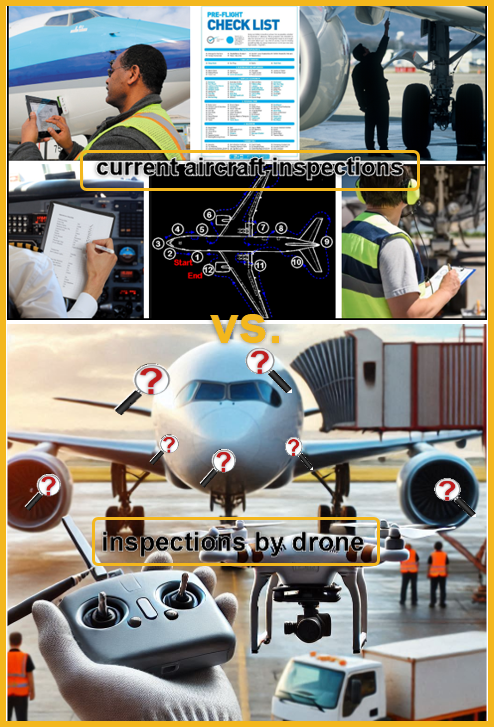New UAS adaptation enhances Aircraft Inspections Safety Value

When Uncrewed Aerial Systems were first introduced, the only limits on their potential was the limits of the operators’ imagination. Amazon and others immediately put them into service as last mile deliveries. First responders found their speed and versatility to be great advantages in their missions. Through a special NASA program (see below), “drones” are now improved instruments of aviation safety inspections.
The below article highlights the NEAR EARTH AUTONOMY (NEA) drones contribution to pre-flight inspections of commercial aircraft. It is claimed that this autonomous system can perform the air carrier preflight checklist in in less than 30 minutes rather than the current expected time of up to four hours. According to the release, aircraft down time is typically $10,000 @ hour!!!
A UAS has obvious superior ability to position itself at the key checkpoints and its maneuverability facilitates movement among the sites to be inspected faster than humans can. The project incorporated a program that incorporated the FAA requirements; its computer assures that all the required points are examined, and the flight pattern is efficiently defined.
Ain’t technology great!!!
- The NEA system captures high resolution images and quickly forwards them to the airlines’ technicians. As opposed to assessing the airworthiness as an individual is on the side of the fuselage and/or subject to the weather, these experts are located in a workplace more conducive to making such judgments.
- This is not a static measurement of the plane’s status; for the system holds a record of past inspections. The evaluation can reference the history of drone-captured pictures of a cracks or fissures or leaks to determine the deterioration more accurately.
- The SYSTEM includes the capability of reminding the technicians of ADs, new company procedures or standards or previous flags by AMTs or Pilots.
It seems clear that this technology is easily adaptable to other mandated inspections:
- Pre-flight Inspections
- Daily Inspections
- Periodic Inspections
- Special Inspections
- Aircraft Inspection Checklist: Best Practices
Introducing a new tool that enhances the time efficiency of, adds to the accuracy/quality and increases the reliability of aircraft inspections is a simple but important INCREASE in AVIATION SAFETY!!!



NASA backed small business revolutionizes aircraft inspections with drones
by Clarence Oxford
Los Angeles CA (SPX) Jan 06, 2025
NEAR EARTH AUTONOMY, a small business supported by NASA’s Small Business Innovation Research (SBIR)[1] program and Boeing, has introduced a drone-enabled solution to streamline pre-flight inspections of commercial airliners. This innovative technology significantly reduces inspection times while improving safety and accuracy.

Traditional pre-flight inspections can take up to four hours and often require manual inspection by personnel climbing around the aircraft. These methods can lead to safety risks and potential diagnostic errors. Near Earth Autonomy’s solution, developed under its Proxim business unit, uses drones to complete inspections in less than 30 minutes[2].
The drones autonomously fly around the aircraft following a programmed task card derived from the Federal Aviation Administration’s inspection requirements. These task cards direct the drone along a precise flight path, allowing it to gather high-resolution data quickly and reliably. According to Danette Allen, NASA senior leader for autonomous systems, “NASA has worked with Near Earth Autonomy on autonomous inspection challenges in multiple domains. We are excited to see this technology spin out to industry to increase efficiencies, safety, and accuracy of the aircraft inspection process for overall public benefit.”
Captured images are transmitted remotely for expert analysis, enabling technicians to make quicker repair decisions. The system also allows comparisons of new photos to archived images, aiding in the identification of issues such as cracks, popped rivets, or leaks. Automated alerts can prompt re-inspections or flag failed components, further enhancing operational efficiency.
Near Earth Autonomy estimates that their drone-based inspection technology can save airlines approximately $10,000 per hour of downtime by reducing unplanned delays. The system has undergone multiple test flights over the past six years on Boeing aircraft operated by major carriers such as American Airlines and Emirates Airlines, demonstrating its effectiveness.
For more information on NASA’s Small Business Innovation Research program, visit here

[1] The NASA Small Business Innovation Research / Small Business Technology Transfer (SBIR/STTR) program is part of America’s Seed Fund, the nation’s largest source of early-stage non-dilutive funding for innovative technologies. Through this program, entrepreneurs, startups, and small businesses with less than 500 employees can receive funding and non-monetary support to build, mature, and commercialize their technologies, advancing NASA missions and helping solve important problems facing our country.
[2] As little as???